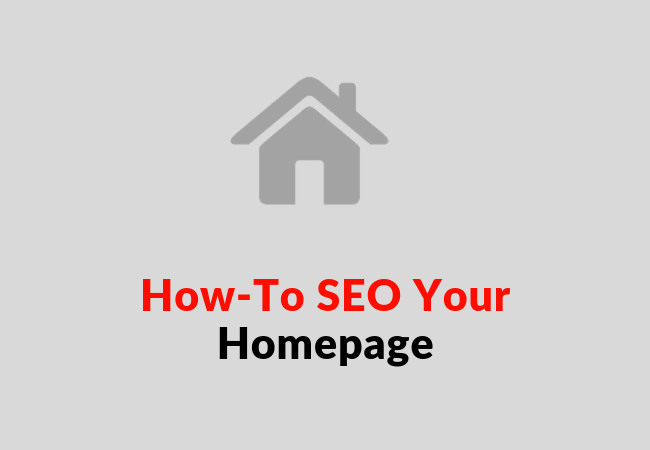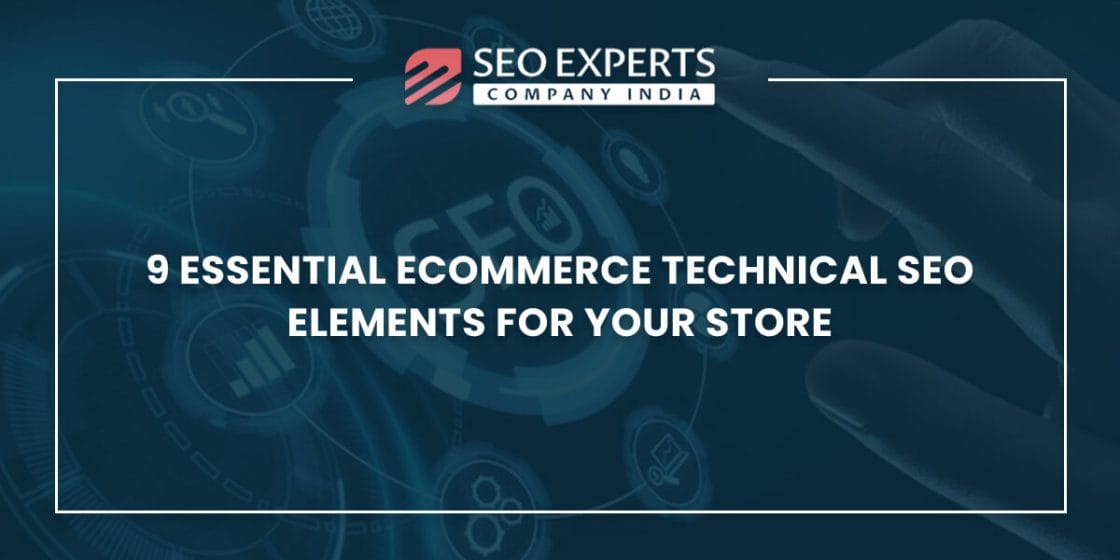It’s a well-known fact that Search Engine Optimization is the key to achieve significant results (in terms of traffic) for your website. However, of all the web pages on a website, optimizing the home page is extremely crucial. Reason being the homepage is the most visited web page on a website. Even if a user lands on another page from SERP, he is more likely to open the home page to know more about your business. Therefore, it becomes significantly crucial to make your home page SEO-friendly.
Homepage SEO – In-Depth Process
Like any other web page, the homepage SEO is also a critical process involving a wide range of crucial steps. If each of these steps is implemented precisely using the best homepage SEO practices, it becomes easier to improve the search engine rankings for your homepage.
Note: It is worth noting that for many businesses their home page is the only source to attract organic traffic. This is one of the many reasons why optimizing the homepage becomes extremely important.
Therefore, the following guide will help you understand the best practices of homepage SEO and how you can utilize these practices to improve the performance of your website’s homepage.
Here are the SEO tips to optimize the homepage.
Optimize Home Page Title.
Optimize Home Page Meta Description.
Optimize H1 tags.
Image SEO.
Optimize Website Logo.
Optimize Home Page Content.
Optimize Loading Speed.
Make Home Page Mobile-Friendly.
Add SSL Certifications.
Let’s discuss each of these points in detail to understand how you can use them to perform effective homepage SEO.
Optimize Home Page Title
The first thing that you need to do is optimize the homepage title. Why? Because it’s the first thing a user and the search engine will notice about your website. You would want your target audience to understand what the business is all about while giving a hint to the search engine about the context of your website. It means that your title needs to be captivating as search-engine friendly at the same time.
Many people tend to make huge mistakes by only using their business name as the home page title. While there’s nothing wrong with using the business name, you should get more creative by providing more information along with it.Take a look at the following snippet, showing the title of Ahrefs home page.
As you can see that Ahrefs has clearly given quite a though while creating the title. On the one hand, it is extremely appealing for the audience, and at the same time, it tells the search engine what the website is all about.
It is also worth noting that Ahrefs hasn’t hesitated in stretching the title up to 60 characters. This shows how you can use the character length to craft the perfect title for your home page as well. Let’s take a look at another example of Neil Patel’s website, i.e, neilpatel.com.
Now, since Neil Patel has already become a renowned brand in the community, he does not need to tell the search engine about his business. Having a high authority is enough for the search engine to rank Neil’s website. However, he has still put in efforts by making his homepage title informative as well as highly appealing so that a new user can understand what to expect on Neil’s website.
To make it a little easy for you, we have scribbled down the important homepage title rules, which you should follow while creating the title for your homepage.
Keep the title length up to 60 characters.
Precisely put keywords in the title. Avoid adding too many keywords as it makes your title too complicated to understand.
If you’re planning on adding the business name, make sure to add it at the beginning of the description.
Avoid keyword stuffing as it can harm the rankings of your website.
Follow these tips and create the perfect title for your website’s home page.
Optimize Home Page Meta Description
Once the user has got his eyes off of the title, the next thing he’s going to notice is the meta description. So, you need to optimize the meta description as well. Keep in mind that if you don’t provide the description, Google’s going to create it on its own, which is the last thing you’d want to happen. This is why it is always advisable to provide a proper meta description for every page, especially homepage, of your website.
While writing the description, make sure to explain the users about the context of the web page itself. While adding keywords is important, you would not want to unnecessarily stuff the description with keywords. Pick the most suitable keyword and try to craft a meaningful and concise description around it.
Keep the description length anywhere between 150 to 170 characters. Google prefers meaningful and shorter descriptions over lengthy ones. So, make sure that the character length does not succeed 170 characters at any cost.
Let’s take a look at some of the examples to understand how a perfect home page meta description looks like.
This is the perfect example of a perfect description. The description is concise, informative and extremely captivating. That’s how you would want your homepage description to look like.
Follow these tips while drafting the meta description for your homepage.
Keep the character length in between 150 to 170 characters.
Infuse target keyword into the description, however, avoid keyword stuffing.
Try to summarize the homepage content within the description itself so that a user can have a clear idea about your website.
Creating actionable descriptions is recommended but do not overdo it.
Optimize the H1 tag
Every web page, including the homepage, should have a unique and only one H1 tag. In most of the cases, if you haven’t manually added the h1 tag, your CMS considers the page title as the H1 tag and puts it in between the <h1> in the HTML code.
The H1 tag appears at the top of the web page. Basically, it tells the customer about what to expect in the page ahead. Like the title and the meta description, you would want to keep the H1 tag as appealing as possible. Optimizing the H1 tag means adding your target keyword to it while ensuring that it is captivating and meaningful.
To check the H1 tag for your homepage, simply right click at any point on the screen and click on the ‘view page source’ button. Press Ctrl+F and type in “h1” This will show you the entire <h1> tag.
Image SEO
Images can be a great asset for your homepage as they make it more appealing. However, you can’t simply put up images on your website, you need to optimize them so that it becomes easy for the search engine to crawl them.
Optimizing images is a crucial part of performing homepage SEO. Here’s how you can optimize images for your homepage.
Add Alt Text to every image. The search engine cannot read the image so it uses the alt text and image caption to get the context. In no case, you would want to leave the alt-text blank for an image. Furthermore, alt-text is also important in instances when the image fails to load. In such a case, the alt-text will be displayed at the place of the image, giving the user a complete context about the image.
Infuse the alt text with your target keywords. However, it’s not always recommended to do this. Keep the alt-texts relevant to the image and naturally add the keywords.
Compress the image size so that it doesn’t affect the homepage loading speed.
Optimize Website Logo
Like every other website on the internet, your website must have a logo as well. However, you should focus on optimizing the website logo to make it more appealing for the audience.
Here’s what you can do to optimize the website logo.
Add your website name to the logo. It looks professional and gives your logo a brand identity.
Since the logo is an image at the end of the day, make sure to add dedicated alt text so that it is optimized for the search engine.
Use proper format for your logo. The most recommended format for website logo is Vector format, which is saved using .AI extension.
Optimize Home Page Content
Your homepage should contain high-quality and engaging content. Since this is the place where a user will find the most information about your business, it is important to add relevant and SEO-friendly content to the homepage. The homepage content mainly depends on your business type.
For instance, if you’re an e-commerce website owner, the homepage should contain information regarding new arrivals, special deals & discounts, and links to other product categories. Similarly, if you’re a corporate business owner, your homepage is more likely to have informative content that best describes your business and services.
It is important that your homepage should have enough content so that the customer understand your services. Furthermore, the content should also contain internal links to other web pages on your website. It is also worth noting that adding keywords to the content is still important. Precisely sprinkle your target keyword to the content while ensuring that it doesn’t lose overall meaning and relevancy.
Optimize Loading Speed
Studies suggest that a user only waits for 3 seconds for a web page to load. If it takes more than that, he’s more likely to click the back button to find another result on SERP. It makes it highly imperative to optimize the homepage loading speed so that a user doesn’t have to wait for too long.
It is important that your website loads as quickly as possible. To do so, you can follow the following practices and optimize the loading speed of your homepage.
As we mentioned earlier, you should always compress the image size. Large images make your website slow and increase the loading speed. Therefore, before uploading an image to your website, make sure to compress it by using tools like Optimizilla, an online image compressor, which reduces the image size without affecting its quality.
If you are running your website on shared hosting, consider switching to a private hosting as soon as possible. Having your own hosting improves the website speed and the overall website performance.
Make sure that your CMS is updated to the latest version as many CMS providers release consistent updates to optimize website speed.
Use PagespeedInsights to check your website’s current loading speed. It is a highly effective tool from Google which also provides recommendations on how you can further optimize the homepage speed.
If you’re planning to upload videos on your homepage, make sure to stream them on Youtube first and only embed the Youtube link on the page. Directly streaming videos on your website can increase the website loading speed.
Make Your Homepage Mobile-Friendly
The majority of internet traffic is coming from mobile these days. Users have completely switched to mobile from desktop. As a result, the importance of providing users with mobile-friendly websites has significantly increased.
Keeping this switch in mind, Google has already implemented Mobile First Index while indexing web pages. It is a technology, recently launched by Google, according to which, the mobile version of the website will be considered over the desktop version while indexing the website.
To check if your website is mobile-friendly or not, simply run a Mobile-friendly-test. The test will display a simple Yes or No answer to tell if a website is optimized for the mobile or not.
In case your website isn’t mobile-friendly, consider using responsive design as it makes your webpages consistent across various platforms. It means that a change that you make to the desktop version of the website will automatically be implemented to the mobile version as well.
In short, making the page mobile-friendly is a crucial part of homepage SEO, and it should not be overlooked at all.
Add SSL Certifications
Having an SSL certificate is a must for every website, be it a corporate website, e-commerce platform, or even a blog. Google has been considering HTTPS as a ranking signal for a while now. It means that if your website still running on HTTP, it is less likely to attain top positions in search engine rankings.
Adding an SSL (Security Socket Layer) certification migrates your website from HTTP to HTTPS, making it more secure. It protects user information from any potential threat and therefore, helps you build better customer relations as well.
Add Navigations
Having proper navigation on the homepage itself makes it easy for both the search engine as well as the customer to navigate through your website. It is important that each web page should be navigable from the homepage itself. However, make sure that none of the web pages take more than 3 clicks to find. Avoid unnecessarily nesting the menu and keep everything upfront.
It is worth noting that a website, which is easy to navigate, is more likely to be crawled by the search engine easily. So, make sure to add proper navigation from the homepage itself.
Bonus Tip – Add Call to Actions
When a new user lands on your homepage, you only have a few seconds to grab his attention. While adding content and images can make it easy to captivate a customer, you should also focus on adding dedicated CTAs (Call to Actions) to the homepage.
Adding links to your service pages, product pages (for e-commerce websites), articles (for blogs), client testimonials, etc. is an effective homepage SEO practice to navigate the user through different pages of your website. So, make sure to add dedicated CTAs to different web pages of your website.
Conclusion
The homepage is a critical element of every website and also the on-page seo optimization process. It needs to be optimized so that it attains top search engine rankings and helps you establish a brand name for your business. The above-mentioned guide will help you optimize your homepage and make it SEO-friendly. Even though these tips are quite easy to implement, we recommend hiring search engine optimization professionals at SEO experts India to do this task. Reason being, they know how to implement the most suitable strategies to optimize your website so that it achieves significant results.









